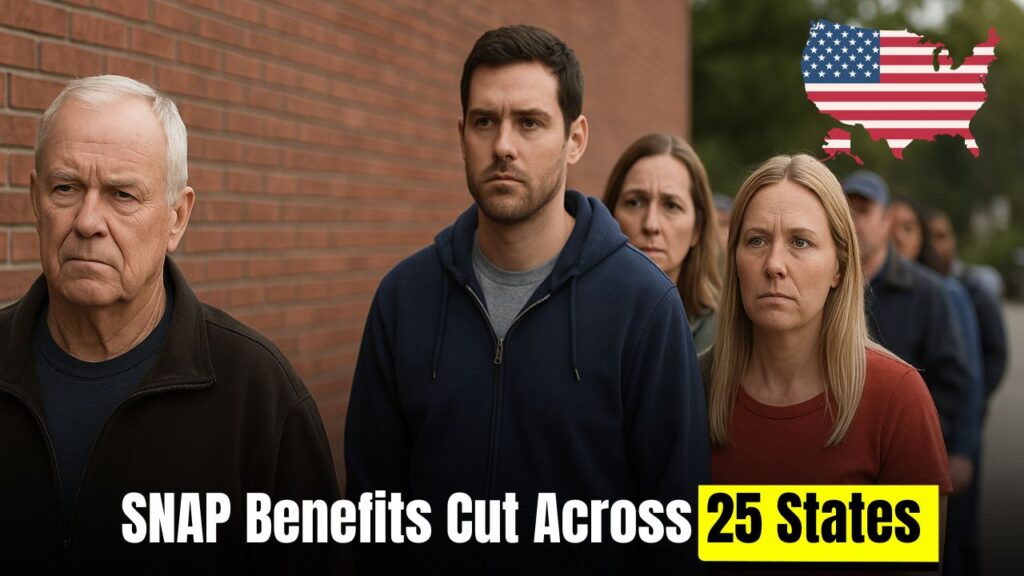SNAP Shutdown 2025 – The Supplemental Nutrition Assistance Program (SNAP), also known as food stamps, is facing major changes in the United States. Starting November 2025, at least 25 states are expected to cut back on SNAP benefits due to updated federal guidelines and budget constraints. These reductions will likely impact millions of low-income families, especially those relying heavily on food aid for survival. As the cost of living continues to rise across America, many individuals and households may face increased food insecurity. This article outlines the key changes, affected states, and what beneficiaries should know moving forward.

SNAP Benefit Reductions to Affect American Families
As of November 2025, millions of low-income American families may experience a significant drop in their monthly SNAP benefits. The U.S. Department of Agriculture has revised the eligibility formula and adjusted maximum allotments in response to budget tightening and inflationary concerns. While SNAP was expanded during the pandemic, that emergency support has ended, leaving many households vulnerable. States like Texas, Florida, Ohio, and Pennsylvania are among the first to confirm their reduction plans. The cuts will particularly affect families with children, seniors, and the disabled. It’s vital for recipients to understand their updated benefit amounts and seek local food banks or nonprofit help if needed.
US Households to See SNAP Cuts Amid Budget Revisions
Millions of households across the U.S. are bracing for tighter food budgets as November marks the beginning of new SNAP policy rollbacks. With 25 states implementing reduced support, many recipients may see a monthly cut of $40–$100, depending on household size. The USDA has urged states to communicate these changes early, but not all have done so effectively. American residents are urged to verify their benefit status via state SNAP portals or mobile apps. This reduction may disproportionately affect rural families, people of color, and those already below the poverty line. The federal government argues the rollback is necessary to curb spending, but advocates warn of worsening food insecurity.
| State | SNAP Changes Start | Estimated Benefit Loss | Affected Households |
|---|---|---|---|
| Texas | 1 November 2025 | $60–$100/month | 2.1 million |
| Florida | 3 November 2025 | $50–$90/month | 1.8 million |
| Ohio | 5 November 2025 | $40–$70/month | 950,000 |
| Pennsylvania | 6 November 2025 | $55–$95/month | 1.2 million |
| Illinois | 8 November 2025 | $50–$80/month | 1.4 million |
SNAP Policy Shift Concerns Families Nationwide
This sweeping change in SNAP policy is sparking concern throughout the United States. With over 40 million Americans relying on food stamps, even minor benefit reductions can have serious consequences for those living paycheck to paycheck. Advocacy groups are urging the federal and state governments to reconsider or at least delay the cuts during the holiday season. For vulnerable communities, this is not just a budget change—it’s a survival issue. Organizations such as Feeding America and local food banks are preparing for a possible surge in demand. Families are encouraged to review their benefit status, appeal unjust reductions, and explore alternative aid programs.
Food Assistance Cuts Alarm Low-Income Americans
For low-income citizens throughout America, the upcoming SNAP cuts represent more than a policy shift—they’re a threat to basic nutrition. With inflation still affecting grocery prices, even a $50 monthly reduction can mean fewer meals. Several states have offered short-term relief grants or charity partnerships, but these may not be sustainable. Community leaders urge Washington to consider the long-term impact of these changes, especially on children and seniors. Households are also advised to seek free school meals, WIC support, and local food distribution events to mitigate the blow of these reductions.
Frequently Asked Questions (FAQs)
1. When will SNAP cuts begin in most states?
The cuts will begin in early November 2025 across at least 25 states.
2. How much will recipients lose in benefits?
Most households will lose between $40 to $100 per month depending on their size.
3. Who will be most affected by these cuts?
Low-income families, seniors, and disabled individuals will be most impacted.
4. Can people appeal their SNAP benefit reductions?
Yes, beneficiaries can contact their state SNAP office to file an appeal.




